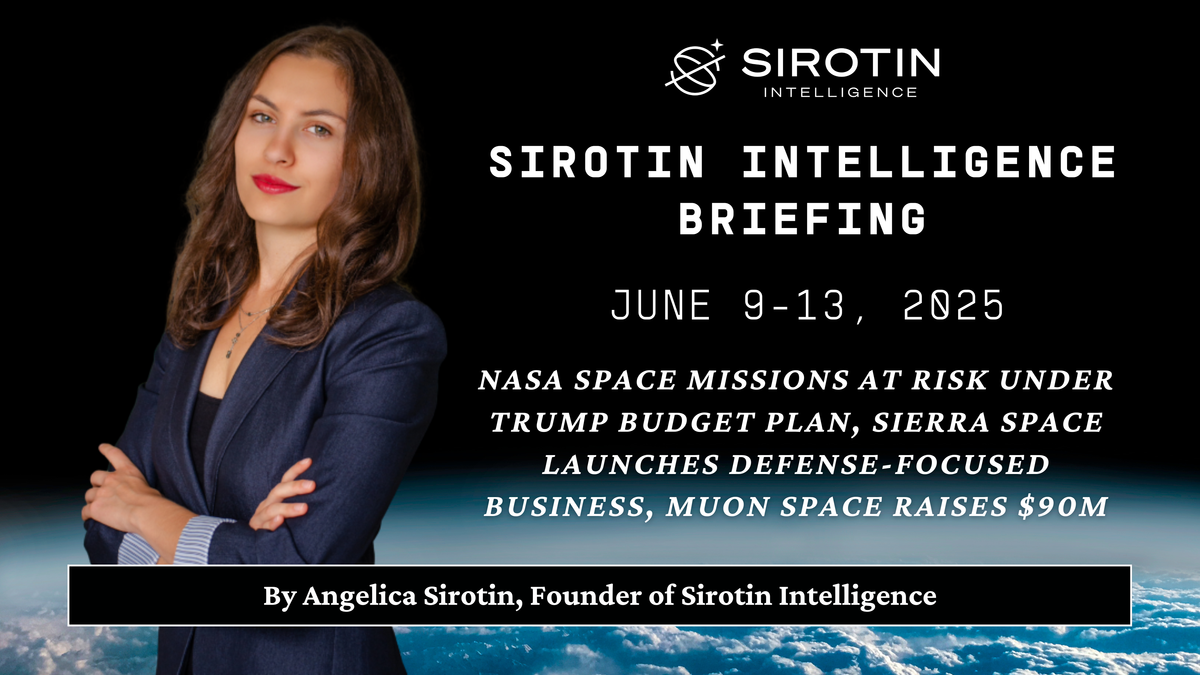Sirotin Intelligence Briefing: June 9-13, 2025: NASA Space Missions at Risk Under Trump Budget Plan, Sierra Space Launches Defense-Focused Business, Muon Space Raises $90M
NASA Space Missions at Risk Under Trump Budget Plan, Sierra Space Launches Defense-Focused Business, Muon Space Raises $90M

This week's space intelligence highlights: NASA space missions face potential cancellation under proposed budget cuts while Sierra Space launches a dedicated defense division and Europe clears the SES-Intelsat merger without conditions. Defense developments accelerate as lawmakers find common ground on space programs despite Golden Dome divisions, Pentagon supply chain issues hamper mega constellation plans, and Chinese spacecraft prepare for orbital refueling tests under US surveillance. Commercial momentum builds with Muon Space raising $90 million to scale satellite production, Voyager's $383 million upsized IPO success, and breakthrough developments in nuclear space power systems. Scientific discoveries emerge as James Webb reveals the first exoplanet raining sand, quantum physicists create fluid-like light simulating space-time, and space weather activity threatens to bring aurora displays as far south as New York and Idaho. Meanwhile, France emphasizes space militarization needs, Africa establishes a unified continental space agency, and the QUAD Security Dialogue prepares to address China's expanding orbital capabilities including spy satellite networks, mega-constellations, and armed space station guard robots. Join us June 19th as power systems expert Mike Swearingen reveals why treating the grid as a living system isn't science fiction but engineering reality we refuse to acknowledge.
🛡️ Defense Highlights
- Sierra Space Launches Defense-Focused Business: The aerospace company established a dedicated defense division to pursue military and national security space contracts, expanding beyond its commercial space station and transportation capabilities. The move reflects growing opportunities in defense space markets as military leaders prioritize orbital security and multi-domain operations.
- Eyes on the Future: Gen. Mike Guetlein Visits Space Rapid Capabilities Office: The Space Force Vice Chief toured the organization responsible for rapidly developing and deploying space technologies to address urgent military needs. General Guetlein's visit underscores the service's emphasis on accelerating capability development to counter evolving threats in the space domain.
- France's Air Space Chief Emphasizes Militarization of Space: French military leadership highlighted the increasing militarization of space and the need for enhanced defensive capabilities as orbital domains become contested environments. The statements reflect Europe's growing recognition that space superiority is essential for modern military operations and national security.
- Lawmakers Find Common Ground on Space but Golden Dome Sparks Divide: Congressional leaders demonstrated bipartisan support for space programs while expressing sharp disagreements over the ambitious missile defense system. The divide highlights ongoing tensions between defense spending priorities and the technical feasibility of orbital interception capabilities.
- Integrate Software Selected by Space Force to Streamline Satellite Launches: The military service chose specialized software solutions to optimize launch operations and reduce mission complexity for satellite deployments. The selection demonstrates the Space Force's focus on operational efficiency and cost reduction in an increasingly competitive space environment.
- Pentagon's Mega Constellation Still Hampered by Supply Chain Issues: A Government Accountability Office report revealed ongoing manufacturing and component delivery challenges affecting the military's ambitious satellite constellation plans. The supply chain bottlenecks threaten timeline delays for critical national security space capabilities as China rapidly expands its orbital presence.
- Space Superiority is Crucial for Joint Force Dominance: Military analysts identified four essential factors needed to achieve space dominance including resilient satellite constellations, advanced sensors, rapid replacement capabilities, and integrated command systems. The framework highlights how space control has become foundational to all modern military operations across domains.
- Chinese Spacecraft Prepare for Orbital Refueling Test as US Surveillance Sats Lurk Nearby: China conducted critical tests of in-space refueling technologies while American intelligence satellites monitored the operations, highlighting the competitive dynamics of space surveillance. The refueling capabilities could extend mission durations and operational flexibility for Chinese military and civilian space assets.
- BAE Systems Brings South Korea's Hanwha Into Intelligence Gathering Constellation: The British defense contractor partnered with South Korean firm Hanwha to develop and deploy intelligence, surveillance, and reconnaissance satellites. The international collaboration strengthens allied space capabilities while expanding commercial opportunities in the growing ISR market.
- Space Force Supports III MEF with Tactical Space Integration: The military service provided direct space capabilities support to Marine Expeditionary Forces, demonstrating growing integration between space assets and ground operations. The collaboration showcases how space-based communications, navigation, and intelligence are becoming essential for tactical military operations.
- House Appropriators Add Almost $3 Billion to President's Request for Space Force: Congressional budget allocators significantly increased proposed Space Force funding beyond the administration's request, reflecting bipartisan support for space capabilities. The additional funding demonstrates legislative recognition that space dominance requires substantial investment amid growing international competition.
- Space Force's First Next-Gen Missile Warning Launch Pushed to 2026: The military service delayed the inaugural launch of its advanced missile detection satellite due to technical challenges and integration complexities. The postponement affects the timeline for replacing aging early warning systems critical for homeland defense and strategic stability.
- Hegseth Questions Air Force Plan to Buy E-7, Touts Space-Based Recon: Defense Secretary nominee criticized traditional airborne surveillance aircraft acquisitions while advocating for space-based intelligence, surveillance, and reconnaissance capabilities. The position reflects the administration's emphasis on space-centric defense strategies over conventional airborne platforms.
🌐 Policy, Geopolitical & Legal Developments
- NASA Space Missions at Risk Under Trump Budget Plan: The administration's proposed budget cuts threaten multiple NASA programs including planetary science missions and Earth observation satellites, raising concerns about America's scientific leadership. The reductions could force delays or cancellations of critical research missions while competitors advance their space capabilities.
- NASA, Axiom Space Delay Axiom Mission 4 Launch to Space Station: The commercial crew mission to the International Space Station has been postponed due to technical and scheduling considerations, reflecting ongoing challenges in commercial human spaceflight operations. The delay highlights the complexity of coordinating private missions with ISS operations and NASA requirements.
- European Space Agency Reveals 3 Key European Space Missions Threatened by Trump's NASA Budget Cuts:ESA warned that proposed NASA funding reductions could jeopardize joint transatlantic missions including Mars sample return and Jupiter exploration programs. The potential disruptions threaten decades of international collaboration and could force Europe to pursue independent space capabilities.
- NASA and Axiom Space Postpones AX-4 Mission Due to ISS Leaks: The private astronaut mission faced additional delays as engineers address persistent air leaks aboard the International Space Station that pose safety concerns. The postponement underscores ongoing infrastructure challenges with the aging orbital laboratory and the complexity of commercial crew operations.
- European Space Agency Partners with Commercial Companies: ESA announced new partnerships with private space firms to accelerate technology development and reduce mission costs through commercial innovation. The collaboration represents Europe's strategy to compete with American and Chinese space capabilities while leveraging private sector efficiency.
- AIAA's Uniquely Interdisciplinary Space Conference ASCEND Poised for Memorable Vegas Event: The aerospace organization's flagship conference will showcase cutting-edge developments across space technology, policy, and commercial applications in Las Vegas. The event reflects the industry's growing interdisciplinary approach to solving complex space challenges through cross-sector collaboration.
- Starliner Future Plans Still in Limbo: Boeing's commercial crew vehicle faces continued uncertainty regarding its operational timeline and mission schedule as technical issues and certification challenges persist. The delays impact NASA's crew rotation plans and highlight ongoing difficulties in achieving reliable commercial human spaceflight capabilities.
- The Commercial Space Federation Announces New Board Officers: The industry trade organization elected new leadership to guide policy advocacy and represent commercial space interests in Washington. The leadership changes reflect the sector's maturation and growing political influence as commercial space becomes central to national security and economic competitiveness.
- Europe Clears SES-Intelsat Deal Without Conditions: European regulators approved the major satellite operator merger without requiring divestures or operational restrictions, clearing a significant hurdle for the transaction. The approval enables creation of a larger combined entity to compete with emerging satellite constellation operators and strengthen European space capabilities.
- Africa's New Space Agency Presents a Unified Space Front: The African Union established a continental space agency to coordinate space activities across member nations and develop shared capabilities. The initiative aims to leverage space technology for development goals while building indigenous space expertise and reducing dependence on foreign providers.
- Quebec Backs Canadian Launch Startup Reaction Dynamics: The provincial government provided significant funding support for the rocket company's development of small satellite launch capabilities from Canadian territory. The investment reflects growing government recognition of commercial space as a strategic economic sector and national security priority.
- Europe Looks to Space Resilience and Autonomy Amid Global Changes: European policymakers emphasized the need for independent space capabilities and supply chain security as geopolitical tensions reshape international cooperation. The strategic shift prioritizes European technological sovereignty while maintaining selective partnerships with allies and commercial providers.
🛰️ Technology & Commercial Developments
- NASA Sensor on Space Station Eyes Contamination Off California Coast: Advanced instruments aboard the ISS are monitoring environmental pollution and water quality along the California coastline, demonstrating the expanding role of space-based Earth observation. The technology showcases how orbital platforms are becoming essential tools for environmental monitoring and disaster response.
- James Webb Space Telescope Sees First Exoplanet Raining Sand Alongside Sandcastle Partner World:Astronomers discovered an extraordinary exoplanet system where one world experiences clouds of silicate particles while its companion exhibits similar extreme atmospheric conditions. The discovery expands our understanding of planetary formation and atmospheric dynamics in alien solar systems.
- Muon Space Raises $90 Million to Scale Satellite Production and Acquire Propulsion Startup: The Earth observation company secured significant funding to expand manufacturing capabilities and integrate propulsion technologies through strategic acquisition. The investment reflects growing investor confidence in specialized satellite constellations for commercial and government applications.
- Voyager Looks to Expanded Defense and Space Opportunities as a Public Company: Following its recent IPO, Voyager Space is positioning itself to capture growing defense contracts and commercial space opportunities through enhanced financial capabilities. The company's public status provides additional resources for scaling operations and pursuing strategic acquisitions in the expanding space economy.
- Coverage Factors Affect Urban CO2 Monitoring from Space: New research reveals how satellite observation angles and urban landscape features impact the accuracy of carbon dioxide measurements from orbit. The findings could improve climate monitoring capabilities and help cities better track their emissions reduction progress.
- Reusable Space Plane Coming to Oklahoma Spaceport in 2027: A commercial aerospace company announced plans to operate reusable launch vehicles from Oklahoma's spaceport, bringing advanced spaceflight capabilities to the American heartland. The development reflects the geographic expansion of space operations beyond traditional coastal launch sites.
- Utah State University Launches the Future of Space Travel: The university unveiled new space technology research initiatives focusing on advanced propulsion systems and next-generation spacecraft design. The programs aim to train the next generation of space engineers while developing breakthrough technologies for deep space exploration.
- Light Has Been Made Into a Fluid That Simulates Space-Time: Scientists achieved a breakthrough in quantum physics by creating fluid-like light that behaves according to Einstein's relativity principles in laboratory conditions. The research could lead to new insights into black holes, gravitational waves, and fundamental physics while advancing quantum computing technologies.
- Quantum Space Raises $40 Million: The satellite servicing company secured significant funding to expand its orbital logistics capabilities and develop advanced robotic systems for space operations. The investment highlights growing commercial interest in extending satellite lifespans and providing maintenance services in orbit.
- Xplore Reveals Hyperspectral Imagery from First Satellite: The space technology company released high-resolution spectral images from its inaugural satellite mission, demonstrating advanced Earth observation capabilities. The imagery showcases the potential for detailed environmental monitoring and resource mapping from small satellite platforms.
- Sun Pole Images Reveal Solar Storm Activity: New imagery from solar observation missions captured dramatic activity at the Sun's poles, providing insights into solar storm formation and space weather patterns. The images help scientists better predict space weather events that can disrupt satellite operations and communications systems on Earth.
- Arkadia Space Tests Its First Hydrogen Peroxide Thruster in Orbit: The company successfully demonstrated its green propulsion technology aboard an orbital testbed, marking a milestone in environmentally friendly space propulsion. The hydrogen peroxide thruster offers a safer alternative to traditional toxic propellants while maintaining high performance for satellite operations.
- A Reinvigorated Push for Nuclear Power in Space: Industry leaders and government agencies are accelerating development of nuclear power systems for space missions, driven by requirements for deep space exploration and high-power applications. The technology could enable ambitious missions to the outer planets and provide reliable power for lunar bases and Mars colonies.
- Voyager Raises $383 Million from Upsized IPO: The space company exceeded expectations in its public offering, raising significantly more capital than initially planned due to strong investor demand. The successful IPO demonstrates renewed market confidence in space companies following the sector's post-SPAC recovery.
- Revolutionizing Space Tech: A Cutting-Edge Alternative to Optical Solar Reflectors: Engineers developed innovative solar panel technologies that could replace traditional reflective systems with more efficient and compact designs. The breakthrough could significantly improve power generation capabilities for satellites while reducing size and weight constraints.
- Reaction Dynamics Prepares for Takeoff: The propulsion company completed final preparations for its launch vehicle debut, positioning itself to enter the competitive small satellite launch market. The company's innovative engine technology promises to deliver cost-effective access to space for commercial and government customers.
- Aurora Alert: Moderate Geomagnetic Storm Could Spark Northern Lights as Far South as New York and Idaho: Space weather forecasters predicted enhanced aurora activity due to solar storm conditions, potentially making northern lights visible at unusually low latitudes. The geomagnetic disturbance highlights the ongoing solar maximum period and its effects on Earth's magnetic field and satellite operations.
💭 A Word From Christophe Bosquillon
The Quadrilateral Security Dialogue (“QUAD") is an informal security partnership between the US, Australia, India, and Japan. Earlier in June, Sen. Michael Bennet (D-Colo.) and Sen. Kevin Cramer (R-N.D.) introduced the Quad Space Act with the aim to strengthen US strategic space coordination with these 3 Indo-Pacific allies.
Rather than funding and program, the detailed Bill reveals the Quad Space Act purpose being for SecDef to open quadrilateral space security talks. The four countries should determine shared priorities for space dominance, space industrial policy, and cooperation, to provide Congress with a roadmap.
This comes at a time when the US Space Force and US Space Command have to deal with increasing space threats originating from Russia and China. China is launching a flurry of spy satellites and mega-constellations, deploying dozens of new launchers, some with chopsticks included, pushing for terrestrial and space-based AI dominance, preparing for orbital refuelling tests, and, last but not least, arming its space station with guard dogs.
The QUAD Security Dialogue Series will be launched in New Delhi on 26 June alongside the India Space Congress. Australia-hosted IAC 2025 adjacent events on 28 September will include the QUAD Security Dialogue Networking Series. As for Japan, the nation has demonstrated its ability to leverage the constraints of its pacifist Constitution's Article 9.
A Center for Security and Emerging Technology (CSET) report on advanced space technologies for US national security, reveals that "Today, U.S. companies find themselves fulfilling roles that were historically the domain of the government, (…) companies are deploying new systems for novel applications at a rapid pace and lower price," thus reinforcing the private sector weight on the space defense industrial base.
General Chance Saltzman posted that "Space is too dynamic for any one nation to secure alone- it takes trust, coordination, and shared commitment to deter aggression." QUAD allies should develop capabilities to address threats in and from space, for which Japan is already advanced. Same for NATO’s European space defense capabilities starting with France.
The question for QUAD and NATO allies being: where do you cross the line toward truly offensive space weaponry?
Have a great space week ahead!
🎤 Our Next Guest: Mike Swearingen
Thursday, June 19th – Mike Swearingen on Why the Grid Is Already a Living System and Our Approach to Grid Autonomy Is Backwards
Mike Swearingen, retired power systems engineer, IEEE Senior Member, and Smart Grid Pioneer, joins us to discuss why treating the power grid as a living, autonomous system isn't science fiction—it's an engineering reality that we refuse to acknowledge, and how this blind spot is creating dangerous vulnerabilities.
🔍 Topics Covered:
- Why the grid already makes autonomous decisions and we just don't label them that way
- How his experience maintaining space equipment during Desert Storm shaped his cybersecurity approach for critical infrastructure
- Why zero trust architectures fail in power systems and what alternative security frameworks actually work
- The dangerous disconnect between engineering and cybersecurity professionals that creates exploitable blind spots
- How F-22 radar concepts can be adapted to create proactive grid defense systems
- Why younger engineers' over-reliance on software without understanding physics creates troubleshooting failures
- How relay systems work as machine code rather than network devices—and why this matters for security
- The lost art of using auditory cues to diagnose power system problems
- How frequency hopping and electronic warfare countermeasures from satellite operations can protect grid communications
- Why policymakers need to listen to operations engineers instead of just utility executives
Don't miss this revealing conversation about how space-domain tactics and old-school engineering intuition can secure the grid of tomorrow.
📚 Essential Intel from Our Archives
Missed a beat? These groundbreaking conversations are must-reads:
"Japan Launched the World's First Wooden Satellite Using Ancient Carpentry"
Space security expert Sylwia Gorska reveals how Japan's constitutional pacifism drives revolutionary space sustainability innovations—from traditional wood joinery satellites to debris removal missions—positioning the nation as an unlikely leader in orbital preservation while deepening its asymmetric defense partnership with the United States.
"I Created a Language That Lets AI Think in 128 Dimensions"
Former corporate sales executive Chris McGinty reveals how his McGinty Equation unifies quantum mechanics with relativity through fractal geometry, creating Hyperfluid AI and revolutionary space-folding technologies now being adopted by NATO defense strategists.
"I'm on a Crusade to Expand the Domain of Life"
Space pioneer Rick Tumlinson reveals how he created the NewSpace movement, his work with Dr. Gerard K. O'Neill, and his 40-year mission to expand humanity beyond Earth through commercial space ventures.
"Space Law Is The First Domain Where Nations Agreed On Rules Before Having Practice"
Military JAG-turned-attorney Trevor Hehn explains how Cold War-era space treaties meet modern commercial ventures, highlighting the challenges of resource utilization, dual-use technologies, and regulatory navigation for companies expanding beyond Earth's atmosphere.
"The Unprotected Power Grid Will Be Our Civilization's Death Warrant If We Don't Act"
Doug Ellsworth, Co-Director of the Secure the Grid Coalition, warns about America's vulnerability to electromagnetic pulse attacks and advocates for urgent power grid protection to prevent catastrophic infrastructure collapse.
"When AI Designs Components, They Sometimes Defy Textbook Engineering"
Space Force Lt. Colonel Thomas Nix reveals how 3D printing and AI are creating revolutionary spacecraft designs, with parts that are stronger and lighter than what human engineers could develop using traditional methods.
"The Gaps in Our Lunar Knowledge Are Enormous"
Extraterrestrial Mining Company Chief Scientist Dr. Ruby Patterson describes the urgent need for more lunar geological data before making commercial decisions, while offering a balanced view on helium-3 mining and advocating for inclusive international cooperation in cislunar space.
"We're Building the Railroads of the Space Gold Rush"
Space Phoenix Systems CEO Andrew Parlock positions his company as "FedEx for space," creating an infrastructure that helps businesses launch and return payloads from orbit with minimal friction.
"Our Nuclear Shield Was Killed For Political, Not Technological Reasons"
Reagan's SDI Director Ambassador Henry Cooper argues that effective missile defense technology developed during the Reagan-Bush years was abandoned for political reasons when the Clinton administration "took the stars out of Star Wars."
"Every Country Has a Border with Space"
UK Space Agency CEO Dr. Paul Bate is developing Britain's space industry through initiatives like spaceports in Scotland's Shetland Islands to establish the UK as Europe's premier satellite launch destination.
"We're Treating Satellites Like They're Still In The 1990s"
Niha Agarwalla, Director of Commercial Space, explains why traditional satellites are obsolete and how resilient constellations will transform space economics.
"When People See Space Guardians in Uniform, They Ask If They're Real"
Colonel Bill Woolf, 25-year space defense veteran, reveals his mission to build public support for the newest military branch defending America's orbital assets.
"One Kilogram of Helium-3 Is Worth $50 Million"
Jeffrey Max, Magna Petra CEO, explains how lunar resource extraction could revolutionize Earth's energy production and fuel humanity's expansion across the solar system.
"I'm Building a Rocket Engine That Could Reach Alpha Centauri"
Michael Paluszek, Princeton Satellite Systems President, reveals how fusion propulsion could reduce travel times throughout our solar system and enable humanity's first interstellar missions.
Chris Newlands, CEO of Space Aye, discusses how his company's satellite technology is revolutionizing wildlife conservation and helping to combat illegal fishing and poaching.
"I Learned From the Last Generation of Manhattan Project Veterans”
Patrick McClure, former Kilopower Project Lead at Los Alamos National Laboratory, explains how small nuclear reactors could power future missions to the Moon, Mars, and beyond.
"We're Being Attacked Every Day"
Christopher Stone, Former Pentagon Space Advisor, warns about America's vulnerabilities in orbit and explains why China's "attack to deter" doctrine makes space conflict more likely than many realize.
"I Helped SpaceX Secure Their First Commercial Contracts"
Serial entrepreneur Robert Feierbach discusses building billion-dollar space ventures across four continents and developing North America's newest spaceport.
"We Can Fly 8,000 Miles In 2 Hours"
Jess Sponable, Ex-DARPA PM & President of NFA, explains how rocket-powered aircraft will revolutionize global travel through simplified hypersonic technology.
"This Could Be Our Biggest Economy"
Kevin O'Connell, Former Space Commerce Director, reveals how space is transforming from a government domain to a $1.8 trillion market.
"How Do You Win a War in Space?"
Ram Riojas, Ex-Nuclear Commander and Space Defense Expert, explains why the next war will start in space and how nations are preparing their defenses.
"First Day on the Job, Hubble Was Broken"
Mike Kaplan, James Webb Space Telescope Pioneer, reveals how early setbacks with Hubble shaped NASA's approach to complex space missions and discusses the commercial revolution transforming space exploration.
The Future of Human Space Habitation
Jules Ross reveals how her journey from artist to space visionary is reshaping human adaptation to space through Earth's first artificial gravity station.
Attorney Michael J. Listner unpacks the complex legal challenges facing modern space activities. From resource rights to orbital debris management
Making Oceans Transparent From Space
Navy Legend Guy Thomas, inventor of S-AIS, shares how his invention transformed global maritime surveillance and security.
Sources
https://www.jpl.nasa.gov/news/nasa-sensor-on-space-station-eyes-contamination-off-california-coast/
https://spacenews.com/voyager-looks-to-expanded-defense-and-space-opportunities-as-a-public-company/
https://www.ft.com/content/8cf3df35-439f-4cbf-9481-a4fad8cdd277
https://www.defensenews.com/space/2025/06/11/sierra-space-launches-defense-focused-business/
https://eos.org/editor-highlights/coverage-factors-affect-urban-co2-monitoring-from-space
https://www.fox13now.com/news/local-news/utah-state-university-launches-the-future-of-space-travel
https://phys.org/news/2025-06-european-space-agency-partners.html
https://spacenews.com/lawmakers-find-common-ground-on-space-but-golden-dome-sparks-divide/
https://spacenews.com/integrate-software-selected-by-space-force-to-streamline-satellite-launches/
https://spacenews.com/quantum-space-raises-40-million/
https://spacenews.com/xplore-reveals-hyperspectral-imagery-from-first-satellite/
https://spacenews.com/pentagons-mega-constellation-still-hampered-by-supply-chain-issues-gao-report/
https://www.michigansthumb.com/news/article/sun-pole-images-solar-storm-20374022.php
https://spacenews.com/arkadia-space-tests-its-first-hydrogen-peroxide-thruster-in-orbit/
https://spacenews.com/a-reinvigorated-push-for-nuclear-power-in-space/
https://spacenews.com/voyager-raises-383-million-from-upsized-ipo/
https://spacenews.com/starliner-future-plans-still-in-limbo/
https://spacenews.com/reaction-dynamics-prepares-for-takeoff/
https://spacenews.com/the-commercial-space-federation-csf-announces-new-board-officers/
https://spacenews.com/europe-clears-ses-intelsat-deal-without-conditions/
https://spacenews.com/africas-new-space-agency-presents-a-unified-space-front/
https://www.dvidshub.net/news/500282/space-force-supports-iii-mef-with-tactical-space-integration
https://spacenews.com/quebec-backs-canadian-launch-startup-reaction-dynamics/
https://spacepolicyonline.com/news/europe-looks-to-space-resilience-autonomy-amid-global-changes/




